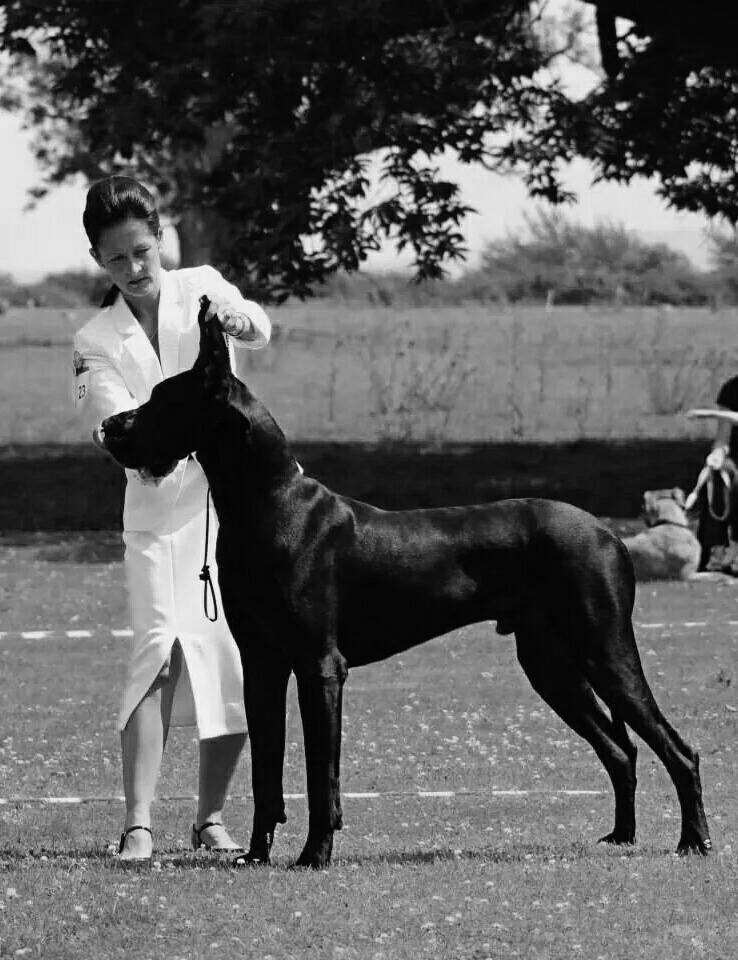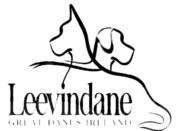Great Dane History
Despite their size, Great Danes are absolute gentle giants, are incredibly playful and great with other animals and children. However, an owner must be willing to accommodate the dog’s great size in regard to space and feeding, which can be costly. Veterinary Bills are larger also so Pet Insurance is recommended

Great Danes like other giant-breed dogs are prone to a condition known as Gastric Dilatation-Volvulus. (GDV) is a rapidly progressive life-threatening condition of dogs. The condition is commonly associated with large meals and causes the stomach to dilate, because of food and gas, and may get to a point where neither may be expelled. To reduce the possibility of this potentially life-threatening problem, feed two or three small meals daily instead of one large one, and encourage rest for at least one hour before and after eating. Limiting gulping of water may also be benficial.
Very large dogs also benefit from raised food bowls so they will not have to splay their legs to eat.
Great Dane Size:
Weight Range:
Male: 165-190 lbs.
Female: 100-120 lbs.
Height at Withers:
Male: 32-36 in.
Female: 30-34 in.
Features:
Natural Ears Set Or may Cropped in the US.
Expectations:
Exercise Requirements: 20-40 minutes/day
Energy Level: Average
Longevity Range: 6-8 yrs though many of our Danes are still going strong at 10 + years.
Tendency to Drool: High Tendency to Snore: Sometimes
Tendency to Bark: Moderate
Tendency to Dig: Moderate Social/Attention Needs: High
Bred For:
Hunting boars, guardian
Coat:
Length: Short
Characteristics: Flat
Colors: Black, Fawn,Brindle, Blue, Mantle, Merle, Harlequin
Overall Grooming Needs: Low
Club Recognition:
AKC Classification: Working
UKC Classification: Guardian Dog
FCI Classification : Utilization
Prevalence: Common
Great Danes are huge, powerful and elegant dogs. Males can reach 32-36 inches tall and weigh anywhere from about 165 to 190 pounds, 75-90 kilos while females may be 30-32 inches tall and weigh about 100 to 120 pounds (45 to 59 kilograms).
The Great Dane’s massive head is narrow and flat on top. The eyebrows are prominent. The ears drop forward or are cropped to stand erect. The neck is long and strong. The Great Dane’s body is long, muscular and the front legs are straight. The tail is medium in length; it is thick at the base and tapers down to below the hocks.
Great Danes are light to average shedders. The coat is short and sleek and comes in a variety of colors including brindle or fawn, blue, black or harlequin, which has black patches over a white background.
The breed has poor longevity; Great Danes live only 6-8 years or less.
Personality:
Great Danes are considered gentle giants. They are incredibly playful, affectionate and great with children. They will guard their home. Great Danes generally get along with other animals, particularly if raised with them.
Great Danes are considered easy to train. Training and socialisation should begin early in their formative stage of life. Exercise should be gentle and moderate until they have fully developed at around 2 years of age.
Living With:
Anyone who wants a Great Dane must be willing to accommodate this dog’s great size. A Great Dane will eat far larger quantities of food than a small dog, so feeding is going to cost a lot more for a Great Dane than, say, for a tiny Chihuahua. but with the Big size comes Big Fun and Big cuddles, Dane style
A Great Dane must have room to move around and exercise, especially when he is young. Anyone wanting to keep a Great Dane in the city must be prepared to take the dog out for long, daily walks.
History:
The Great Dane, also known as the Apollo of dogs, is a giant breed. The breed is thought to have been around for more than 400 years. Great Danes descend from mastiff-like dogs that were bred by German nobility to protect country estates and hunt wild boar.
In the 18th century, Great Danes were prestigious guardians of estates and carriages. They were also popular with the upper class for sport, as few other dogs could bring down a wild boar.
The Great Danes that were more like those we know today were developed in the 1800s. In 1880, the Germans banned the name “Great Dane” and called the breed “Deutsche Dogge,” which means German mastiff; however, the breed continues to be called Great Dane in English speaking countries.
